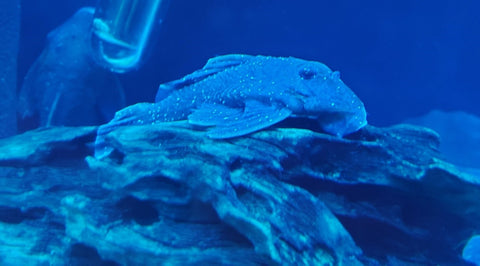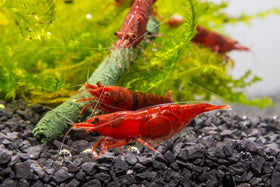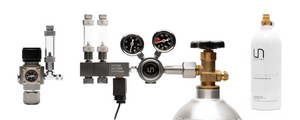
How to Quarantine Aquarium Fish
Written by: Tammy Law (@aquarist_tl) and Team Buce Plant
One of the major reasons people new to fishkeeping end up quitting the hobby is because they are unaware of how to maintain their fishes’ health. If they constantly run into problems trying to keep fish alive, eventually they will think that aquariums just aren’t for them. To solve this problem, all they need is a little more insight on what could be causing these issues.
In this article, we will go over the topic of setting up a quarantine system for fish. Quarantining new fish is an extremely important step in keeping your fishy friends happy and healthy. Read on to see why we should quarantine and how it can be done!
Why Should You Quarantine Your Fish?
Let’s say you have an already established aquarium with healthy residents living in it, but you would like to add more fish in. You then proceed to go to your local fish store, where you purchase some fish that you think would be great additions to your tank at home. Next thing you know, weeks pass by after adding them into the tank and you notice you begin losing more and more fish. This is a common occurrence for inexperienced hobbyists because they do not know about the potential dangers of adding new fish into the aquarium.

A blue panaque pleco (L239) in a quarantine tank that contracted ich (Ichthyophthirius multifiliis), a common external parasitic disease for freshwater fish.
New fish are prone to having illnesses. This is largely due to the stress they endure to get to your aquarium. The fishes found in local fish stores typically come from fish farms, where fish are bred and raised in mass quantities. They are then sold to an importer if the fish farm is located in another country. The importer will then sell it to wholesalers, who sell to the fish stores where aquarists directly buy their fish from. That is when the fish reach their final destination: a hobbyist’s aquarium.
So, the fish are constantly being packed and shipped again and again, traveling in small crowded bags until they reach the fish stores. By this time, they have endured so much stress that their immune system is likely to have weakened and they can easily catch illnesses.
Once a customer purchases one of these potentially sick fish and adds it into their own aquarium, then the illnesses from the new fish can spread to the original inhabitants. In severe cases, if the owner of the fish tank does not notice or know what is occurring in their tank, it can lead to a complete wipeout of all the livestock.
Therefore, it is vital to get into the habit of quarantining new or sick fish in order to prevent this from occurring. Quarantining your new fish will ensure they are healthy and are safe to add into the tank with your other fish.
In the case of a sick fish already in the main aquarium, it is recommended to also quarantine that fish. Especially if the aquarium it is in is large, putting it into its own smaller tank to treat with medicine would save a lot of money and give the fish its own peaceful area to heal.

The ich spread to the other inhabitants of the tank, rapidly multiplying and attaching itself to the fishes’ bodies, eyes, and gills. Medicine was added to treat the ich, making the water turn blue.
- Note: It is not necessary to quarantine new fish going into a new aquarium or an aquarium with no inhabitants since there’d be no fish to possibly spread illnesses to.
How to Quarantine Fish
The process of quarantining fish consists of isolating them into their own tank or container until they are deemed healthy enough to join the main aquarium. Usually, quarantine tanks are small tanks, around 10 gallons, because they are quick to set up and it is easier to find a spot to fit a small tank in compared to large tanks. The smaller size also helps save money if you are using medicine to speed up the quarantine process.
Like any other aquarium, you will need the basic fishkeeping equipment: a filter and a heater for those who live in colder areas. A great filter that Buce Plant offers is the Qanvee Sponge Filter because you have the option of adding your own cycled media into the built-in chambers to instantly cycle the new tank! It just requires an air pump and some airline tubing to run the sponge filter.
A quarantine tank only needs the bare minimums, so it does not need to be scaped or have substrate. It doesn’t even have to be an actual tank. You can use any container like a storage bin, as long as it can safely hold water. A quarantine tank is just a simple, temporary setup to house the new or sick fish in.

Qanvee Sponge Filter available at Buce Plant
- Note: It is recommended to keep everything that touches the water of the quarantine tank separate from other aquariums to avoid cross contamination, such as aquascaping tools or cleaning supplies like gravel vacuums, buckets, and algae scrapers.

After several days of treatment, the ich was almost completely gone.
Once the quarantine tank is set up and cycled properly, you can then acclimate the fish as normal before placing them in the tank. (Click here to learn more about cycling an aquarium.) You will care for the tank as you normally would with regular water changes. Feed the fish as normal.
The length of time for quarantining ranges between 2-4 weeks and depends on which process you choose to use: medicated or not. If going down the medicated route, you would add the recommended fish medication into the tank right when you add the fish in. Treating or medicating your new fish preventatively will kill any bacteria or parasites. For sick fish showing symptoms of particular illnesses, you would treat for those certain illnesses, following the instructions and dosages provided with the medicine. You can follow up with a second treatment just to make sure the fish are healthy. Once fish are healthy, then you can add them to your tank.
Even if the fish are not showing symptoms of any illnesses, you can still treat them with medicine as a preventative measure. This will speed up the quarantining process to a recommended period of at least 2 weeks. If you choose to not use medication, then they should be in the quarantine tank for at least 4 weeks.
During the fishes’ time in quarantine, it is essential to keep an eye on them to spot any potential illnesses, so that they can be treated right away.

In order to avoid mass casualties and keep your fish safe and healthy, quarantining new fish plays a vital role. When I first started out in this hobby, a lot of my fish would suddenly die on me and I had no clue as to why. It wasn’t until I learned about the importance of quarantining that the mortality rates began dropping. I hope that through this article I can pass on this knowledge to new hobbyists so that they don’t give up on aquariums, and they choose to stay and enjoy this wonderful hobby!
Tell us - Was this article helpful? Please comment your thoughts below!
If you have any questions regarding this article, please DM us on Instagram or Facebook so we can assist you - @buceplant





Comments
Leave a comment